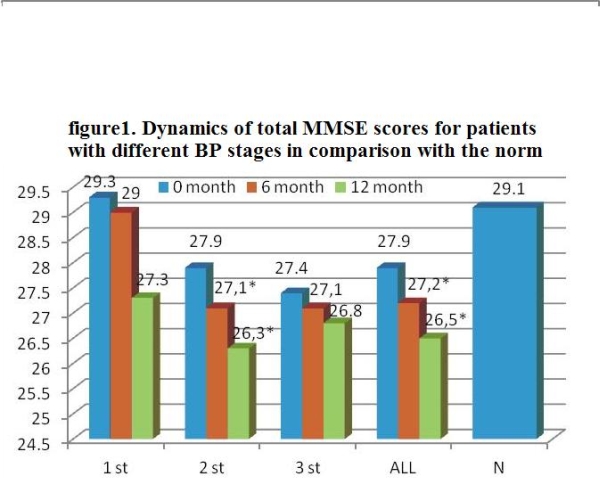Session Information
Date: Tuesday, June 21, 2016
Session Title: Parkinson's disease: Pathophysiology
Session Time: 12:30pm-2:00pm
Location: Exhibit Hall located in Hall B, Level 2
Objective: To investigate postural impairments (PI) and their interrelation with non-motor symptoms in patients with Parkinson’s disease (PD).
Background: PI mechanisms are only partially known. The conventional dopaminergic drugs are not effective enough for their therapy. Disclosure of the PI interrelation with the other dopamine resistant symptoms of PD can help to understand the PI pathogenesis and to develop new directions in their therapy.
Methods: 76 PD patients (mean age 63) with Ist – IIIrd Hoen–Yahr stages (mean 2.17) and 18 healthy volunteers (mean age 56) were examined using UPDRS, MMSE and stabilography tests described in the table1. This examination for PD patient was repeated three times in (0 – 6 – 12 months). PASW Statistics 17.0 was used to handle the data.
Results: Comparison of PD patient stabilography data with the norm showed that patients with the Ist and IInd stages worse performed two tests: staying on a platform when calculating white circles and stability test. Easy fatigability and standing imbalance during optokinetic test with interchanging stripes were accrued in the IIIrd PD stage. The received data show that calculating beeps didn’t influence on patent stability.
| Stabilography tests (patient is staying on a platform): | 1st visit | 2nd visit | 3rd visit | |||
| Mean stage 2,17 (76 patients) | I stage (8 patients) | II stage (49 patients) | III stage (19 patient) | Mean stage 2,3 | Mean stage 2,48 | |
| Eyes are open | – | – | – | – | * | * |
| Eyes are closed | – | – | – | – | – | – |
| Eyes are closed, calculating beeps | – | – | – | – | – | – |
| Calculating white circles, which are mixed with colored ones on a screen | * | * | * | * | * | * |
| Follow stripes running across the screen up | – | – | – | – | * | * |
| down | – | – | – | * | * | – |
| right | – | – | – | – | – | – |
| left | – | – | – | * | – | – |
| Stability test: Superimpose the centre with a mark running across the screen to the right, to the left, up and down by turn | * | * | * | * | * | * |
 Correlation of stabilography and MMSE parameters appeared in the IIIrd stage. The test performance of all PD patients significantly deteriorated in 6 and 12 months.
Correlation of stabilography and MMSE parameters appeared in the IIIrd stage. The test performance of all PD patients significantly deteriorated in 6 and 12 months.
Conclusions: Postural deficit is present already in early PD stages. Negative influence of the cognitive visual load on the test performing was revealed. It can be explained by visual dysfunction appeared in pre-clinical stage of PD or by the beginning cognitive deficit evolution. But the test with the cognitive audio load revealed no influence on the test results. Note that both tests include the same cognitive load, notably calculation. So we consider the visual impairments as the most possible cause of the above poor test performing. Correlation of cognitive and postural impairments was seen the most clearly in the IIIrd stage.
To cite this abstract in AMA style:
A. Pilipovich, V. Golubev, G. Ptimat. Postural and nonmotor disturbances in Parkinson’s disease [abstract]. Mov Disord. 2016; 31 (suppl 2). https://www.mdsabstracts.org/abstract/postural-and-nonmotor-disturbances-in-parkinsons-disease/. Accessed December 29, 2025.« Back to 2016 International Congress
MDS Abstracts - https://www.mdsabstracts.org/abstract/postural-and-nonmotor-disturbances-in-parkinsons-disease/
